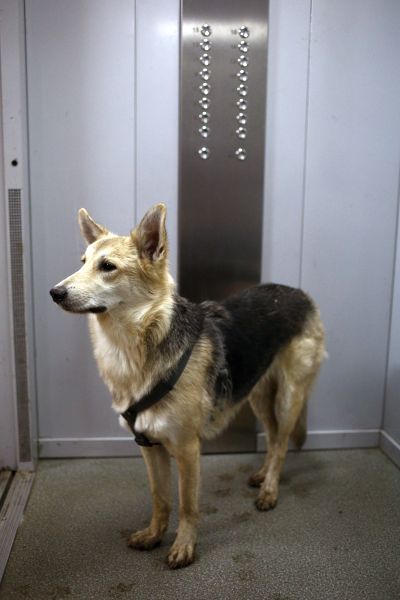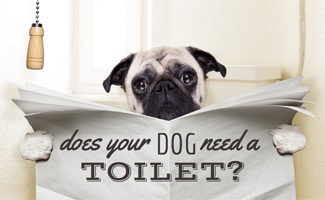When Does a Dog Litter Box Make Sense?

Indoor potties and litter boxes aren’t a good solution for all dogs and owners, but they definitely have their place for some people and pets.
Some of the most common situations in which they may help include:
Owners with mobility issues. If you have trouble getting around very well, you’ll surely appreciate the convenience indoor potties provide. While a litter box or patch of grass won’t completely eliminate your dog’s need to go outside, it will certainly reduce his need to do so as often, which will make your life easier.

Dogs with bladder-control issues. Some dogs simply have more trouble holding it than others – particularly small breeds with tiny bladders. While belly bands may provide some help with this issue for male dogs, an indoor bathroom facility will often be more convenient to use.
Owners living in high-rise apartments. More and more apartments are accepting dogs as tenants, but just because your dog is welcomed by the management doesn’t mean it is easy or convenient to walk down (and back up) several flights of stairs with your pooch three to five times a day. Even if you have an elevator, bathroom trips are still quite an ordeal. An indoor potty helps to reduce the number of trips you’ll need to take each day.
Young puppies going through the house-breaking process. Pee pads and other types of indoor bathrooms have been used to aid in the training process for decades, and there’s a good reason why: They work. Not only do they help teach your dog that there are right and wrong places to relieve themselves, they also help contain the inevitable messes that accompany the process.
Owners who live in areas with inclement weather. If you live in an area with long, cold winters or sweltering summers, you may find a litter box or some other type of indoor potty to be very helpful. This is especially true for those living in snow-covered areas, as they’ll eliminate the need to put your dog’s booties on (not to mention your own winter garb) three or four times a day.
Owners who are away from the home for long periods of time. While it is never ideal to leave your dog alone for lengthy periods of time, it is sometimes unavoidable. Indoor potty spots help keep your dog from having to sit cross-legged all day long, waiting for you to get home.
Dogs who are recovering from illness or injury. If your dog has been battling illness or recovering from an injury, your vet may recommend keeping him as calm, quiet and still as possible. By utilizing an indoor bathroom of some type, you can reduce the number of trips your dog needs to take outdoors.
Dogs who are afraid of the outdoors. If your is dog scared of going outside, you may want to try an indoor potty while trying to build his confidence.
It is also worth mentioning that most litter-box-style products work better with smaller dogs than larger dogs.
Larger dogs not only produce a lot more poop and pee than small dogs do, they often require more of a “runway” to trigger their elimination instinct. Nevertheless, many owners of dogs in the 40- to 60-pound range find indoor bathrooms effective.
Having a backup potty option can provide you with valuable peace of mind and is worth considering if you have the space. In the event that your dog does need to go inside, at least it will be in a contained space.
Do Litter Boxes Work for Poop, Pee, or Both?
Most litter boxes and indoor bathrooms are appropriate for #1 or #2, although some handle poop better than others. You’ll simply need to remove the solid material, discard it and then clean the potty spot in the appropriate manner.
Keep in mind that litter boxes are not designed to completely eliminate trips outside – they are designed to reduce the number of trips you must take. Accordingly, most owners still take their dog out to poop once or twice a day, and primarily use the litter box as a place to tinkle.
Cat litter boxes are generally used for cats that are never let out of the house for reasons such as medical or maybe for safety, and for just normal indoor cats. I believe that this is what most dog owners are interested in and are looking into from time to time as to whether or not it is advisable to use litter boxes or trays for dogs, and if it is safe for them to use or not.
These are some reasons that some dog owners become keen on getting cat litter for their pups, for when the need arises, it is available for them to use and not leave their dogs in discomfort. But first, we have to find out…
Take note that the above-mentioned is in case you only use the cat litter for your dogs but if you have a mixed household, meaning, you have both cats and dogs, then the situations will be different. This is because your dog might mistakenly eat cat litter with your cat’s poop clumped in it. This may tend to clump in more in your dog’s body and accelerate blockage which results in swelling of the intestines causing them to vomit or suffer from constipation. However, if caught early, these symptoms can be treated quickly by their vet.
The simplest answer for this is yes as some dogs can be easily trained to use them in no time. Dogs are generally trained to do their business usually in the backyard, however, there may be situations where they may be unable to do so. For instance, if you are not home and you are forced to leave your pup at home for a while, if your dog is unwell, or if the weather is awful and it makes it impossible to go outside. I mean, there are even dog potties specifically designed for them.
The good news is that most clumping and non-clumping litters are not really toxic to animals and even humans, e.g. Pretty Litter. Therefore, if your pup mistakes the cat litter for treats or kibbles and snack on them, you can rest assured that they won’t get intoxicated but the worst they could get is only an upset stomach. However, if these are consumed in large quantities, it may result in something worse and if the symptoms become worse, just consult your pup’s resident veterinarian.
Litter Box Training A Dog Pros And Cons
 Housetraining is part of being a responsible pet parent. Whether it’s puppy training or caring for an elderly dog with incontinence issues, this task can come with obstacles and headaches for some dog owners. Overcoming accidents in the home can be difficult for both you and your dog. Thankfully, developments in the dog toilet industry offer pet owners many solutions. Can you train a dog to use a litter box? You can and more with these dog toilet training tips.
Housetraining is part of being a responsible pet parent. Whether it’s puppy training or caring for an elderly dog with incontinence issues, this task can come with obstacles and headaches for some dog owners. Overcoming accidents in the home can be difficult for both you and your dog. Thankfully, developments in the dog toilet industry offer pet owners many solutions. Can you train a dog to use a litter box? You can and more with these dog toilet training tips.
The term “indoor dog toilet” can refer to various products. Here are the six major types of toilets to consider. Click on the links to jump to specific products our experts have reviewed below.
Now that you know the various ways to get your dog to pee inside, here are some of the best indoor dog potties and pros and cons for each.